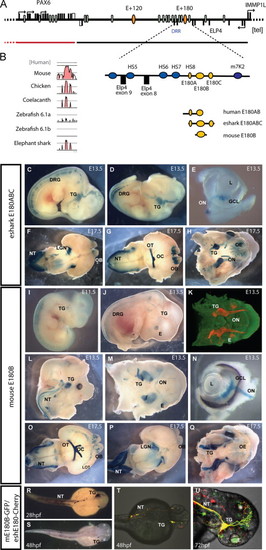Fig. 3
- ID
- ZDB-FIG-140417-22
- Publication
- Bhatia et al., 2014 - A survey of ancient conserved non-coding elements in the PAX6 locus reveals a landscape of interdigitated cis-regulatory archipelagos
- Other Figures
- All Figure Page
- Back to All Figure Page
|
Characterisation of the E+180 conserved element. (A) Overview of the PAX6 downstream region indicating the position of the E+180 element at the telomeric end of the DRR. (B) The E+180 element contains three peaks of sequence conservation between human, mouse, chicken, coelacanth and elephant shark, but no significant conservation is seen in the zebrafish pax6 loci. A schematic overview of putative cis-elements in the telomeric half of the DRR shows the location of the E+180 elements and the fragments used in the transgenic reporter experiments. (C)–(H) Reporter transgenic mice with the E180 fragment from elephant shark (E180A/B/C). Strong expression is present at E13.5 in the trigeminal ganglion (TG) and in the dorsal root ganglia (DRG) along the neural tube (NT). At E13.5 expression also appears in the ganglion cell layer (GCL) of the eye (E) and in the optic nerves (ON). At E17.5 staining is present in the olfactory bulbs (OB) and olfactory epithelium (OE), in nerve tracts along the neural tube and hindbrain, and remains strong in the trigeminal ganglion and nerves. Expression is also present in the retinal ganglion cells, and staining extends along the optic nerve, chiasm (OC) and optic tracts (OT) to the lateral geniculate nuclei (LGN). (I)–(Q) Transgenic embryos with the mouse E180B only fragment. Reporter expression first becomes apparent from E11.5 in the trigeminal ganglion and increases in strength towards E13.5. Expression in the ganglion cell layer of the retina and in the optic nerve starts around E13.5 and continues to manifest at E17.5 in the retinal ganglion cells, optic nerve, chiasm and optic tracts and lateral geniculate nuclei. Staining is also seen in the olfactory bulbs and epithelium. (R)–(U) The mouse and elephant shark E180 fragments were also tested in reporter transgenic zebrafish. In situ hybridisation with a GFP antisense probe on mE180B-GFP transgenic fish shows the expression in the trigeminal nerve and tracts along the neural tube. Dual colour fluorescence in mouse E180B-GFP and elephant shark E180-mCherry double transgenic fish show the near-complete overlap in expression. |
| Gene: | |
|---|---|
| Fish: | |
| Anatomical Term: | |
| Stage Range: | Prim-5 to Long-pec |
Reprinted from Developmental Biology, 387(2), Bhatia, S., Monahan, J., Ravi, V., Gautier, P., Murdoch, E., Brenner, S., van Heyningen, V., Venkatesh, B., and Kleinjan, D.A., A survey of ancient conserved non-coding elements in the PAX6 locus reveals a landscape of interdigitated cis-regulatory archipelagos, 214-228, Copyright (2014) with permission from Elsevier. Full text @ Dev. Biol.

